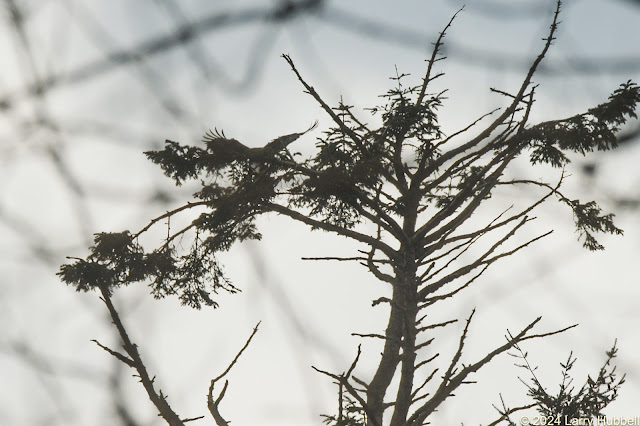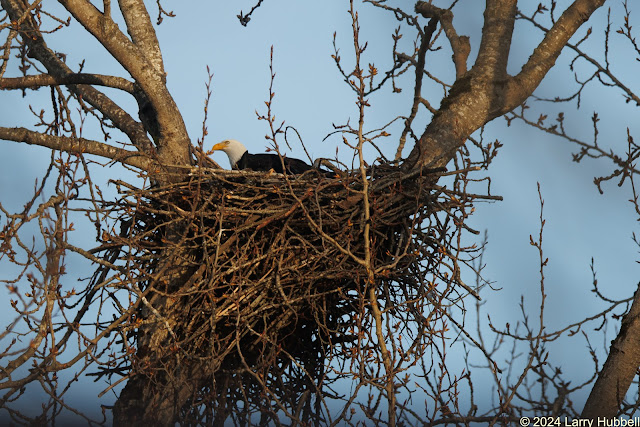On March 7th, my friend Susan Ott, was the first to notice the Montlake Bald Eagles behaving like they had eggs in their nest. (Thank you, Susan!) In the past, it has often been toward the end of March or early April before our local Bald Eagles appear to begin incubation.
For example, last year, my first sighting of an eaglet in the Montlake nest (Thanks again to Susan!) was on May 21st. Working backwards, assuming 35 days of incubation, and expecting that the sighting happened in the ten days before the eaglet began to develop its second darker set of colored down, this implies that the egg containing this eaglet was probably laid during the first week of April in 2023. (
Click Here to read the post from last year.)
If these assumptions are correct then Monty and Marsha have begun incubation almost a full month earlier this year. They also seem to be early as compared to our other resident Union Bay Bald Eagle pairs.
My friend Ronda has noted that Talia, the female in the nest on the old Talaris property on the north side of Union Bay, just began incubating around March 20th. This is just over a week earlier than her normal start date, which Ronda explained has been March 28th in the past.
On Thursday, March 21st, 2024, at the Broadmoor nest tree Albert was in the air, and excitedly lowering himself toward Eva, clearly hoping to once again initiate the egg-laying process.
Admittedly, because of the backlighting and obscuring foliage, it is hard to see what is happening, but I have no doubt about their reproductive behavior. In any case, as of March 21st, I had not seen either of them low in the nest, in an obvious incubating position.
On the other hand, every time I have checked on Monty and Marsha, after March 7th, one of the two has been in the nest.
This March 7th, 2024 photo shows one of the Montlake pair sitting in the nest with their wing tips pointing skyward. In years past, my friend Martin explained, that this positioning implies the eagle is lowering the middle portion of its wings on each side of the egg (or eggs) to help protect them. Because of the structure of their wings, when they do this their dark wing tips point upward. I have never seen this behavior except in the Spring during the time they are likely to be incubating eggs.
When the mate arrived in the tree it began cleaning its bill. In general, the female Bald Eagles are said to spend the majority of the time on the eggs but their mates come and take turns so the females can have a chance to find food and eat. Given that this eagle was wiping its bill on the branch it seems likely that it had just fed.
Curiously, this bill-wiping process, called feaking, has multiple benefits for birds. In addition to cleaning, researchers say it can help sharpen their bills and in some cases, the birds may be leaving a scent to attract potential mates. Click Here to read more about feaking. By the way, Monty and Marsha have a new nest this year. If you have visited them before the new nest will not be hard to find. It is in the closest possible tree to their old nest, i.e. just south of the totem pole on the southeast corner of Montlake Cut. Luckily, this year's nest seems to be built on a firmer foundation.
If you would like to see the new nest, visiting in the next week or two would be wise, before this Spring's leaves obscure the view.
Last year's nest was built on a simple, dual-branched, fork in a tree. The nest looked a lot like a pair of saddle bags draped over a horse's back, but without a cinch to hold it.
When young eagles are preparing to fledge they bounce around a lot while practicing their liftoffs and landings. The stress on a nest increases dramatically. Multiple times over the years, Monty and Marsha's nests have fallen. Often their offspring have found themselves on the ground and unable to fly, which is a very dangerous situation for a young eagle. Sometimes, the nests have lasted a bit longer and the young have been able to fly to safety when the nest fell. (Click Here to read what happened with last year's eaglet and nest.)

Even while incubating appears to be underway, the eagles still occasionally apply finishing touches to the new nest.
Hopefully, the new nest stays in the tree, the eggs hatch and the parents provide a bountiful supply of food for their young. If everything goes according to plan their next set of young might leave the nest before the end of June. (Mid-July has been more typical in the past.)It will be fun to see if the young from this nest are visible sooner than the young in the Talaris and Broadmoor Bald Eagle nests i.e., Will Monty and Marsha's young be the early birds this year?
Based on Susan's observation I am thinking the earliest hatch date is probably around April 11th. It will then take some time for the young to become mobile and strong enough to be seen above the edge of the nest. Potentially, the first sighting of this year's young, in the Montlake nest, will probably be in the second half of April.
In the meantime, you will be far less likely to see pairs of adult eagles in their favorite hunting spots. In Monty and Marsha's case that would be the Cottonwood tree in front of Husky Stadium.
For the next month or so, I would expect one adult, from each of the local pairs, to be in the nest incubating the eggs or protecting the young after they hatch. Initially, the other adult will often be sitting nearby watching the nest. They will be waiting and ready to fly over and protect the nest, their mate, and their developing offspring from danger or harassment.
However, after the young hatch, the demand for food will constantly increase. Ultimately, in two to three months the young will be larger and most likely eating more than the parents. Coming soon, there will be plenty of eagle action, i.e. hunting, to observe around Union Bay.
Have a great day on Union Bay...where nature lives in the city and Black Birders are welcome!
Sincerely,
Larry
Each of us, who breathes the air, drinks water, and eats food should be helping to protect our environment. Local efforts are most effective and sustainable. Native plants and trees encourage the largest diversity of lifeforms because of their long intertwined history with our local environment and the local native creatures. Even the microbes in the soil are native to each local landscape.
I hope we can inspire ourselves, our neighbors, and local businesses to respect native flora and support native wildlife at every opportunity. I have learned that our most logical approach to native trees and plants (in order of priority) should be to:
1) Learn and leave established native flora undisturbed.
2) Remove invasive species and then wait to see if native plants begin to grow without assistance. (When native plants start on their own, then these plants or trees are likely the most appropriate flora for the habitat.)
3) Scatter seeds from nearby native plants in a similar habitat.
4) If you feel you must add a new plant then select a native plant while considering how the plant fits with the specific habitat and understanding the plant's logical place in the normal succession of native plants.
***************
Keystone native plants are an important new idea. Douglas Tallamy, in the book "Nature's Best Hope ", explains that caterpillars supply more energy to birds, particularly young birds in their nests, than any other plant eater. He also mentions that 14% of our native plants, i.e. Keystone Plants, provide food for 90% of our caterpillars. This unique subset of native plants and trees enables critical moths, butterflies, and caterpillars that in turn provide food for the great majority of birds, especially during the breeding season.
Note: Flowering plants and trees, i.e. those pollinated by bees, are also included as Keystone Plants.
This video explains the native keystone plants very nicely:
https://www.youtube.com/watch?v=O5cXccWx030
The Top Keystone Genera in our ecoregion i.e. Plants and trees you might want in your yard:
Click Here
Additional content available here:
https://wos.org/wos-wp/wp-content/uploads/2022/10/Native-Plant-Resources-10-7-22.pdf
******************
In the area below, I am displaying at least one photo with each post to help challenge us to know the difference between native and non-native lifeforms.
Both of the plants below do well locally. One is native to our area and benefits the local birds and bees, one is not and tends to crowd out beneficial native plants. Do you know their names and which is which?
A.
B.
Scroll down for the answer.
******************
A.
Salmonberry: A native plant with early flowers that attract hummingbirds and bees. To help with identification in the winter, notice the golden-brown color and the zig-zag pattern of the stalks.
B.
Reed Canary Grass: An invasive grass that is most easily removed if recognized early and removed promptly.
*****************
The Email Challenge:
Over the years, I have had many readers tell me that Google is no longer sending them email announcements. As of 2021, Google has discontinued the service.
In response, I have set up my own email list. With each post, I will manually send out an announcement. If you would like to be added to my personal email list please send me an email requesting to be added. Something like:
Larry, Please add me to your personal email list.
My email address is:
LDHubbell@comcast.net
Thank you!
*******************
The Comment Challenge:
Another common issue is losing your input while attempting to leave a comment on this blog. Often everything functions fine, however, sometimes people are unable to make it past the robot-detection challenge or maybe it is the lack of a Google account. I am uncertain about the precise issue. Sadly, a person can lose their comment with no recovery recourse.
Bottom Line:
If you write a long comment, please, copy it before hitting enter. Then, if the comment function fails to record your information, you can send the comment directly to me using email.
My email address is:
LDHubbell@comcast.net
Sincerely,Larry

















